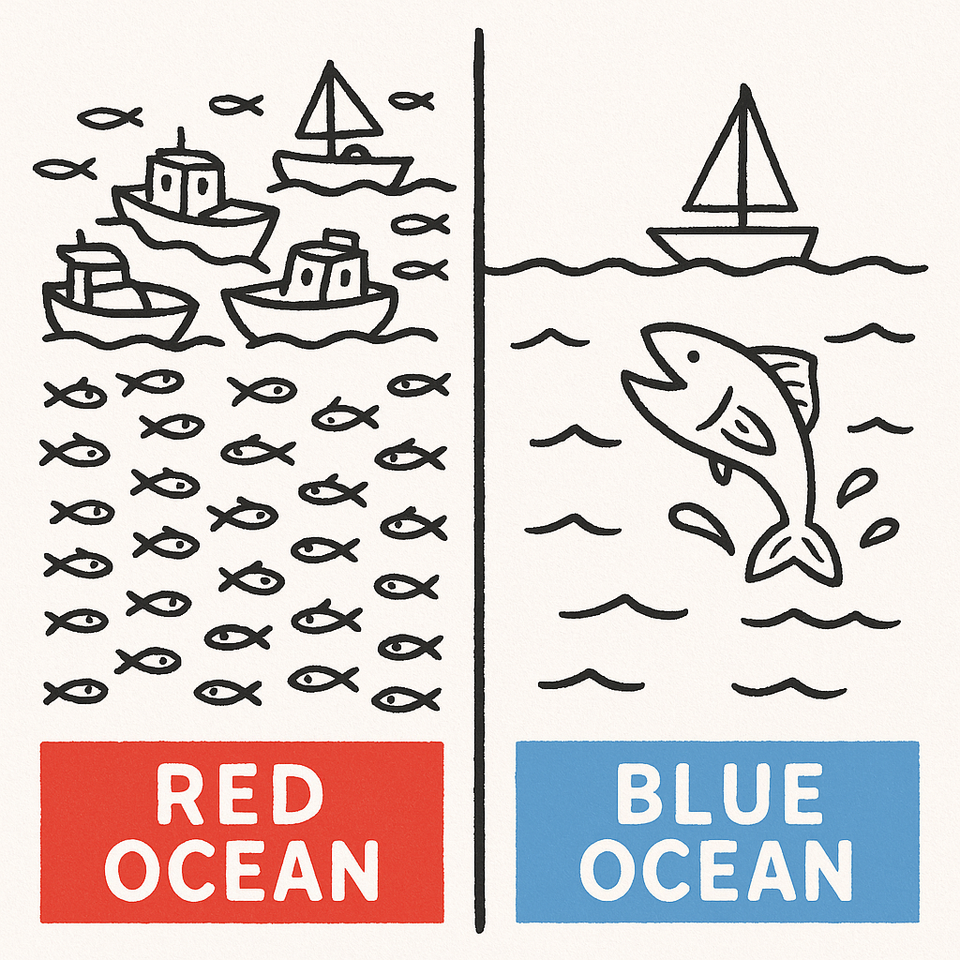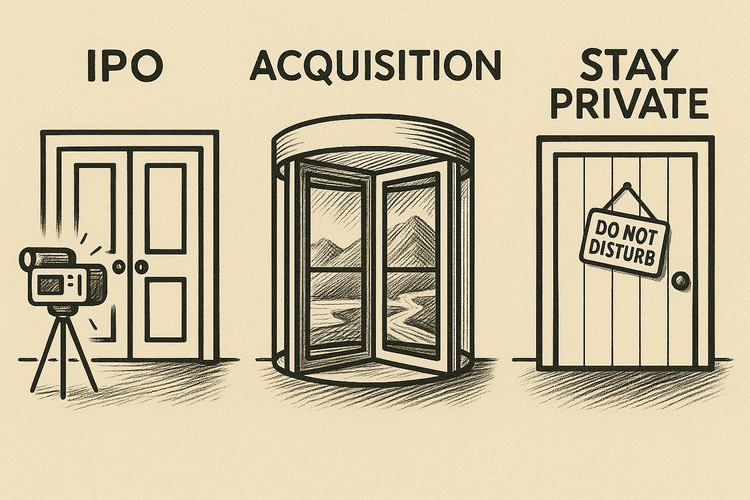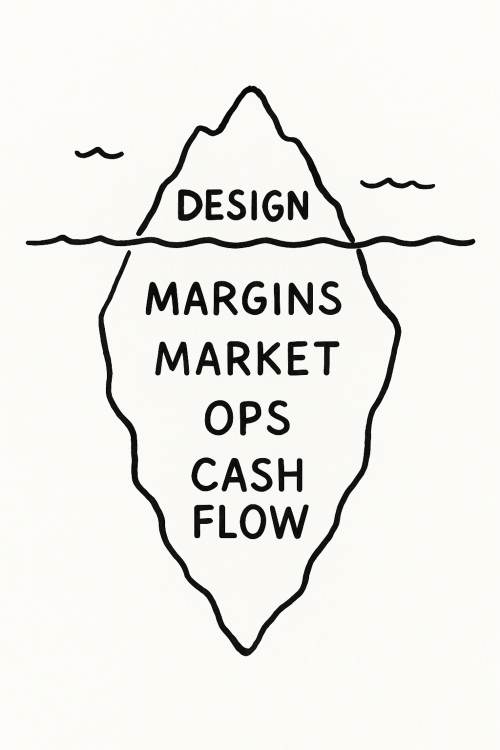Ocean Conditions: Red vs Blue Ocean

W. Chan Kim and Renée Mauborgne’s book Blue Ocean Strategy popularized the terms "red ocean" and "blue ocean" as shorthand for describing the level of competition in different markets. Red oceans are mature markets where companies fight tooth and nail for slices of existing customer demand, turning the ocean bloody with competition. Blue oceans are untapped, uncontested markets where competition virtually doesn't exist or is less relevant.
For designers, understanding the competitive landscape of their industry is foundational to their success. Misunderstanding market conditions will lead to misplaced priorities and wasted effort. Let's take a closer look at red vs blue ocean market conditions.
Red Ocean
These markets are crowded, competitive, and saturated. You win by fighting for market share, optimizing efficiency, and differentiating through details. Understanding your growth strategy is especially critical here (more on that in a later chapter).
Working in red ocean markets can be very rewarding. If you are someone who likes to really hone your craft and get into the fine-grained, nerdy details of design, a red ocean market is the place to do that. Continual optimization and honing and refining the experience is critical to success.
However, if you like to be more of a trailblazer and enjoy making sense of ambiguous problems, a red ocean market may feel very restricting. I once spoke to a recruiter from Google that perfectly illustrated this problem for me. She asked me, "What do you enjoy about being a designer?"
"I love solving big problems," I responded.
She hesitated for a moment, and then said, "How do you feel about solving really small problems?" Her response made it clear to me that this particular team at Google was not for me.
Examples of Red Ocean Markets
- Project management tools
- CRMs
- Video conferencing
- Large language models
Design Implications
- Clear differentiation is critical. Since every customer has seen something like your business before, you need to make the ways in which you're different and better immediately clear. Brand voice, aesthetics, and personality are hugely important.
- Details matter. Small differences in experiences can lead to big outcomes (positive or negative). Fine-tuning details of critical experiences is hugely important. Hopefully this means experimentation, testing, and collecting user feedback is a regular part of your workflow, but this will vary by organization.
- Well-defined key metrics. It's likely that your organization knows exactly which key metrics it's optimizing for. Learning how your work impacts those metrics will be important for your job development within the org.
- Frictionless onboarding. People already know how to use products in your category. They don’t want to learn. Your onboarding should be so seamless it almost disappears.
- Performance is a critical part of the experience. Responsiveness, reliability, and uptime are a critical part of the user experience in crowded markets. Beautiful design won’t redeem a laggy, slow product.
- Microcopy and nuance matter. In saturated markets, small changes in flow, button labels, or error handling can meaningfully influence conversion, retention, and customer perception.
- Optimization, not trailblazing. The majority of your time will go into adding onto or refining existing products and feature sets. It will be very rare to build out an entirely new product.
Blue Ocean
These are open waters. Products in these markets serve new categories, new behaviors, and potentially utilize unfamiliar technology. You’re not fighting competitors so much as you are educating the market on what your product can do for them and why it matters. Blue ocean markets currently include non-LLM or niche AI companies.
Working in blue ocean market conditions can be a jarring experience for designers. Finding product-market fit can be difficult for any company, but it is especially challenging in a blue ocean environment. I once worked for an AI startup that utilized AI technologies to automate financial and banking processes. I was surprised by how many conversations revolved around what the product actually was, what it could be, and what it shouldn't be. There were many meetings where we discussed how to package and articulate the different feature sets we offered. It seemed like every week we trying out a new angle.
For some designers, this can be an invigorating and exciting environment to work in. For others, they may feel as though the ground is constantly shifting under their feet. Blue ocean companies are very high risk/high reward. If the product takes off, you potentially have a huge addressable market with very few competitors. If it doesn't, the whole company could cease to exist with little notice.
Examples of Blue Ocean Markets
- Many non-LLM AI technologies
- AI applications for niche markets
- Despite being staples for so many now, Netflix and Airbnb both launched into blue ocean markets
Design Implications
- Education first. You’re not just designing a product, you’re building understanding. Expect to build flows, demos, and storytelling moments that explain the category itself, not just your feature set.
- Exploratory design. Because users have no mental model yet of how your product works, you product may need more experimentation to validate and dial in your design direction.
- Novel design patterns. You will have fewer examples of existing products and experiences that you can use as inspiration for design direction. You may need to explore design patterns that are unlike what you've seen in other products, or that apply existing patterns in a novel way.
- Narrative alignment. The story the company tells in marketing and the experience a user has in the product must reinforce one another. Misalignment can quickly kill trust in markets that don’t yet exist in users’ minds.
- Visual and physical metaphors. Since users may not have an existing mental model that your product fits inside of, you will need to employ visual and physical metaphors to help build their understanding.
- Trust-building over feature depth. Early adopters will forgive missing functionality, but they will be hesitant to utilize a product that doesn't fit in an existing mental model. This is especially true if you are using new or unfamiliar technologies that perform critical tasks.
- Slow adoption and feedback. Trying to build adoption in a blue ocean can be slow work, and it can be difficult to determine if you're headed in the right direction. Getting user feedback can also be very challenging, as your user base may be very small initially.
- Category shaping. Your work as a designer can influence how a burgeoning market perceives your category. Care should be given when choosing visual metaphors, information architecture, and terminology. When done well, it can become the industry default.
- Design outside the product. In a blue ocean, your craft may extend into pitch decks, demo scripts, educational content, and narrative tools. The experience is as much the story as it is the software.
How do I know if I'm in a red or blue ocean?
If you're still unsure of whether you are operating in red ocean or blue ocean conditions, here's a quick evaluation guide to help.
| Evaluation criteria | Red Ocean | Blue Ocean |
|---|---|---|
| We focus mainly on: | Competitors | Building understanding of what the product is and how it's beneficial |
| Explaining the product to someone else is: | Pretty straightforward | Takes a lot of explanation |
| How features and products are grouped and sold is: | Very clear and defined | In flux |
| New features are usually: | Part of an existing feature set | For a whole new capability |
| When explaining our product: | I can just use words | I find myself relying on sketches or diagrams to convey my thoughts |
| What the product is and is not: | Is clearly defined | Changes on a regular basis |
| When it comes to the competition: | I can easily name 5 competitors | I can maybe think of 1 or 2 |
| Mergers and acquisitions in my industry are: | Commonplace | Rare or unheard of |
Is there a purple ocean?
While "purple ocean" is not a commonly used term, I have worked for a number of companies that fit this description. These are companies that started off in a blue ocean but are now facing a growing wave of competition. While once revolutionary and groundbreaking, they are seeing new companies enter into the category they created and build on the foundation they laid.
This is a tricky and perilous time for an organization. It can be very difficult for the founders and long-time employees to realize that they have sailed into new waters that require change. When new employees are hired into the organization, it is usually obvious to them that the company needs to adapt. This can create a rift between long-time employees and new blood as they wrestle for control of the company's future.
However, this can be a great environment for an experienced and disciplined designer who can introduce new methods, skills, and processes to the organization. As the company looks to find its new direction, you can play an instrumental part in that process.
Design Implications
- Reskilling and refocusing will be needed. A different focus and skillset is needed to operate in a red ocean. This will require the introduction of new methods and skills to the company. It will also mean that some long-time employees will need to exit.
- Developing features and then abandoning them may be common. As competition surges, your company will inevitably begin to loose some business. Leadership may become fixated with every feature that has cost them a sale. Product development may feel more like plugging holes or box checking than following any kind of North Star or vision.
- Toxic resistance. As new ideas are introduced to the company, some long-term employees may feel attacked and turn toxic in their efforts to stave off change.
- Developing buy-in to more mature methods and practices is critical. A good deal of time will be required to introduce and develop buy-in to a new way of doing things. Things that might not have mattered previously to the company, such as a product-led onboarding process, may become critical for future success. Patience and thought leadership will be required to lead the company to greater design and product maturity.



Member discussion